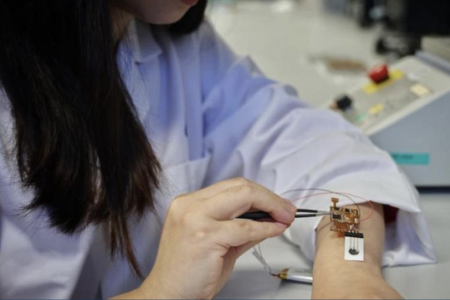New sensor can detect cholesterol and glucose from skin
A new, non-invasive method may do away with the need to draw blood for testing blood glucose and cholesterol levels.
Researchers from the National University of Singapore (NUS) and the Agency for Science, Technology and Research (A*Star) have developed a stretchable, hydrogel-based sensor that can detect such biomarkers in a solid state on the skin.
The technology could be used in wearables for purposes such as chronic disease management and remote patient monitoring.
The team’s findings were published in the scientific journal Nature Materials in June.
While traditional methods of monitoring biomarkers in fluids such as blood, urine and sweat are effective, they come with hurdles that can impede the early diagnosis and treatment of diseases.
Blood tests, for example, can be invasive and inconvenient, while sweat can be difficult to induce in inactive people.
The researchers noted that such challenges do not apply to solid-state epidermal biomarkers – which include cholesterol and lactate – that are found in the stratum corneum, the outermost layer of the skin.
Such biomarkers have shown strong correlations with diseases such as cardiovascular disease and diabetes. Outside of some scattered literature, these correlations have been overlooked for decades, said Assistant Professor Liu Yuxin from the NUS Institute for Health Innovation & Technology.
Prof Liu, who is one of the leads for the study, said solid electrodes placed on the skin, used in conventional monitors, do not allow for the electrochemical sensing of these biomarkers.
Instead of electrodes, the sensor developed by the researchers uses hydrogels, which dissolve and diffuse solid-state epidermal biomarkers that then undergo electrochemical reactions catalysed by enzymes.
This results in the transfer of electrons to an electronically conductive hydrogel, which can then be read by a flexible printed circuit board connected to the sensor.
The circuit board is able to wirelessly transmit the relevant physiological data to a user, who can use the data to monitor a patient’s health.
Dr Yang Le, principal scientist and head of the sensors and flexible electronics department at the A*Star Institute of Materials Research and Engineering, said the sensor is possibly the first such device that is able to monitor biomarkers on dry skin.
“The stretchable design enhances comfort and accuracy as well, by adapting to our skin’s natural elasticity. This innovation can change the way we approach health and lifestyle monitoring, particularly for those living with chronic conditions requiring constant health monitoring,” said Dr Yang, who is the study’s other lead.
Clinical studies showed that the sensor found “strong correlations” between biomarkers on the skin and those in blood samples, positing that it could act as an alternative to blood tests for monitoring chronic diseases such as diabetes and cardiovascular conditions.
It is also able to detect solid-state lactate and cholesterol, even at very low levels.
High levels of lactate, also known as lactic acid, can be indicative of a number of diseases, such as pulmonary or circulatory disorders, and liver disease.
One possible application of the technology is as a replacement for the pregnancy diabetic test, said Prof Liu.
The test for gestational diabetes – which affects about one in five pregnant women in Singapore – is offered to all women who are between 24 weeks and 28 weeks of pregnancy here.
“Rather than subject pregnant women to multiple blood draws, our sensor could be used to track real-time sugar levels conveniently in patients’ homes, with a similar level of accuracy as traditional tests. This also can be applied to diabetes in general, replacing the need for regular finger-prick tests,” Prof Liu said.
Dr Yang identified the daily monitoring of heart health as another possible use of the innovation.
“The research team has embarked on a research programme to work closely with cardiologists in establishing clinical correlation between biomarkers – lactate, cholesterol and glucose – with heart health,” she said.
While the sensor is currently limited to these three biomarkers, the researchers aim to expand its abilities to detect others as well, she added.
Noting that the sensor can eventually be integrated with a variety of devices, including smartwatches and fitness trackers, Dr Yang said the technology can be employed both for lifestyle and medical purposes.
The researchers expect to be able to commercialise the sensor within the next five years or so, once the technology is more mature, she added.
Medical wearables are becoming increasingly popular, with market researcher Fortune Business Insights predicting that the global market for such devices is expected to grow from $120 billion in 2024 to $427 billion by 2032.
Get The New Paper on your phone with the free TNP app. Download from the Apple App Store or Google Play Store now


